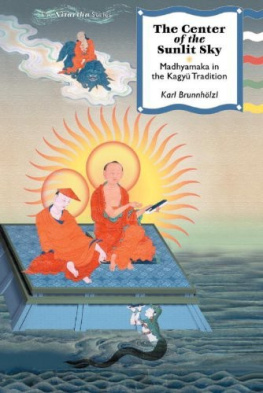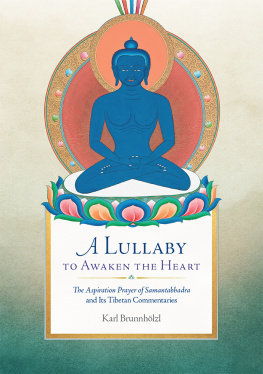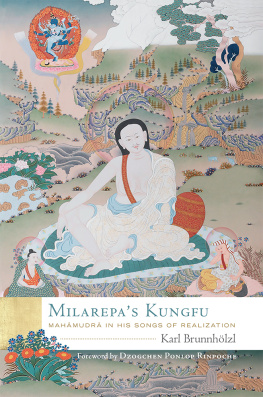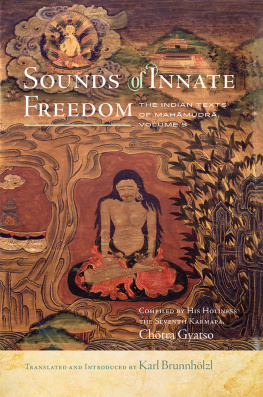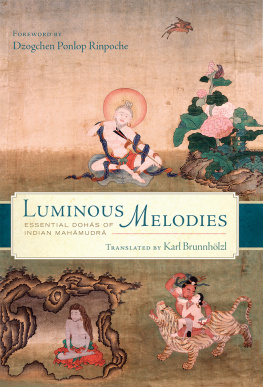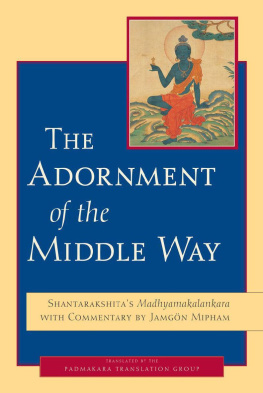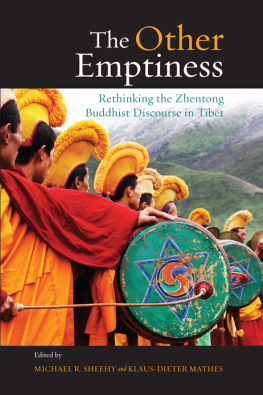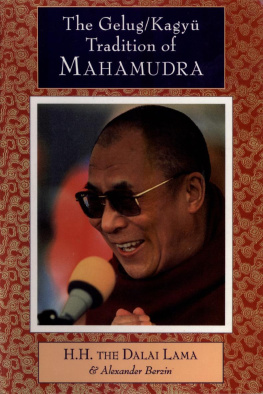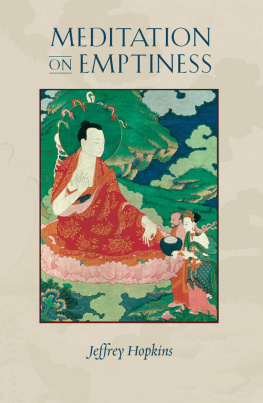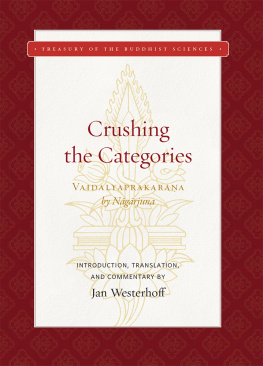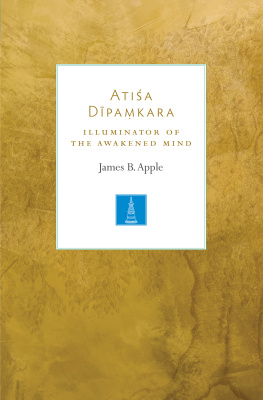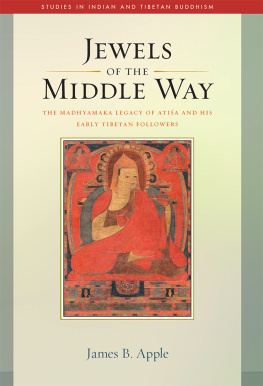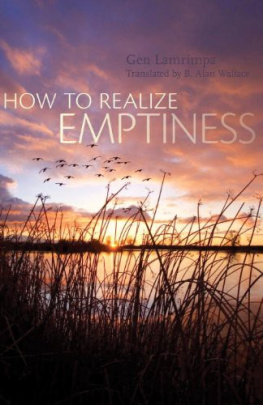THE CENTER OF THE SUNLIT SKY
THE NITARTHA INSTITUTE SERIES
published by Snow Lion Publications
Nitartha Institute was founded in 1996 by The Dzogchen Ponlop Rinpoche, under the guidance of Khenchen Thrangu Rinpoche and Khenpo Tsultrim Gyamtso Rinpoche, the leading contemporary teachers of the Karma Kagyu tradition of Tibetan Buddhism. The Institute, under the aegis of Nitartha international aims to fully transmit the Buddhist tradition of contemplative inquiry and learning; it offers Western students training in advanced Buddhist view and practice, as taught by the Karma Kagyu and Nyingma lineages of Tibet.
The Institute is pleased to ally with Snow Lion Publications in presenting this series of important works offering a wide range of graded educational materials that include authoritative translations of key texts from the Buddhist tradition, both those unique to the Kagyu and Nyingma lineages and those common to the wider scope of Indo-Tibetan Buddhism; modern commentaries by notable lineage scholar-practitioners; manuals for contemplative practice; and broader studies that deepen understanding of particular aspects of the Buddhist view. The initial releases are from the Kagyii tradition and will be followed by publications from the Nyingma tradition.
This publication is an Intermediate Level Nitartha book.
THE CENTER OF THE SUNLIT SKY
Madhyamaka in the Kagyu Tradition
Karl Brunnholzl
Including a Translation ofPawo Rinpoche's Commentary on the Knowledge Section of Sdntideva's The Entrance to the Bodhisattva's Way of Life (Bodhicaryavatara)



Contents
Rangtong-Shentong Controversy in Tibet 500
Two Philosophical Systems of the Great Vehicle 515
Much ado about nothing.
William Shakespeare
"0 young lady, who gave you this self-confidence of yours?" "The Elder himself imparted it to me, because this self-confidence of mine would not have arisen if the Elder had not questioned me."
From The Sutra of the Prophecy of the Young Lady Excellent Moon
Breathe the form of Madhyamaka-open sky Feel the sound of Madhyamaka-roaring silence Open up to the touch of Madhyamaka-letting go Be thrilled by the taste of Madhyamaka-equality's variety Get soaked within the scent of Madhyamaka-freedom innate
Resistance is liberation No point in fighting You are all surrounded by yourself
Give up the surroundings Don't defend your headquarters
And conquer the citadel of
self-surrender
Acknowledgments
Tins BOOK would never have conic into existence were it not for The Dzogchen Ponlop Rinpoche telling me in his usual, seemingly casual way, "You should write an introduction on Madhyamaka for your translation of Pawo Rinpoche's commentary on the Bodhicaryavatara." At first, I took this remark as a joke. However, Rinpoche kept coming hack to this idea. He even became very specific about what such an introduction should include and which texts should be consulted, so I could not but start taking this project more seriously. It rapidly grew from a mere introduction into quite an extensive volume of its own, partly because Rinpoche, at each of our meetings over the years, added topics to be included. Thus, my sincere gratitude and respect go to The Dzogchen Ponlop Rinpoche for his original idea and his continuous inspiration and guidance throughout the entire project. Even greater is the kindness and skillfulness of Khenchen Tsultrim Gyamtso Rinpoche, who for many years has guided Western students through the world of Tibetan Buddhist scriptures with their various philosophical systems and terminologies. Without him, I would not have much of a clue about the intricacies of the Buddhist teachings and their practical application. Further thanks go to Acharya Lama Tenpa Gyaltsen, who helped with many questions about translation. I am also very grateful to all the Western scholars, particularly Prof. Lambert Schmithausen and Dr. Klaus-Dieter Matthes, who opened my eyes to the richness and profundity of both the Sanskrit language and the Yogacara tradition.
Sincere thanks go to Sidney Piburn and Jeff Cox from Snow Lion Publications for their readiness to publish this text. Tracy Davis and Steve Rhodes deserve thanks and praise for being very meticulous and caring editors. My heartfelt gratitude is also extended to Mette Harboe and Carmen Rumbaut for their untiring diligence in accomplishing the first volunteer phase of editing, in terms of English as well as content. They are both to be commended for offering many helpful suggestions and insights, as are Linda Patrik and Jirka Hladis. Thanks to Julia Martin for her assistance with the bibliographic research in Vienna and Stephanie Johnston for preparing the charts. Regarding the financial side, I would like to express my deep gratitude to a dear friend and anonymous benefactor who alleviated my task of self-sponsoring, and to Nitartha Institute for assistance during the final phase of the project. I would also like to thank the Tsadra Foundation for funding the preparation of the index. Last but not least, I am very grateful to all the people in Europe, Asia, and North America who contributed to the text through their discussions with me and/or by providing food and shelter while I was working all over the globe on this nomad project.
In particular, I feel very pleased and honored that this book marks the beginning of the Nitartha Institute Series as an expression of the activities of the Nitartha Institute (under the direction of The Dzogchen Ponlop Rinpoche). This series is designed as a timely attempt to present the scriptural traditions of both the Kagyu and Nyingma schools of Tibetan Buddhism to a wider Western audience.
Over the years, I have had the good fortune to be able to sip a few random drops from the vast ocean of the Buddhist teachings, but I no doubt lack the attainments of a true scholar. I never completed the traditional three-year meditation retreat, so I have no realization either. And not being a native speaker of either English, Tibetan, or Sanskrit, I do not have sufficient command of any of these languages. In brief, there isn't anything to qualify me to write a book like this. In doing so, I have only tried to comply with the wish of The Dzogchen Ponlop Rinpoche. It lies in the nature of such a project that there is no certainty that it will benefit anybody else. What is certain, though, is that I myself learned a lot during the writing process, for which I am extremely grateful. So, if there is anything in what follows that sounds good, makes sense, and serves as an antidote to suffering, may it be enjoyed as coming from realized masters and scholars who know what they are talking about. Everything else, including all mistakes, can safely be said to be mine.
May this book serve as a contributing cause for the enlightened activity of H. H. the Seventeenth Gyalwang Karmapa Urgyen Trinlay Dorje that swiftly and unimpededly embraces all sentient beings without exception. May it in particular assist in sustaining the pure scholarly tradition of the Karma Kagyu lineage as it was initiated and upheld by all the Karmapas as a means to liberate beings from ignorance and suffering.

